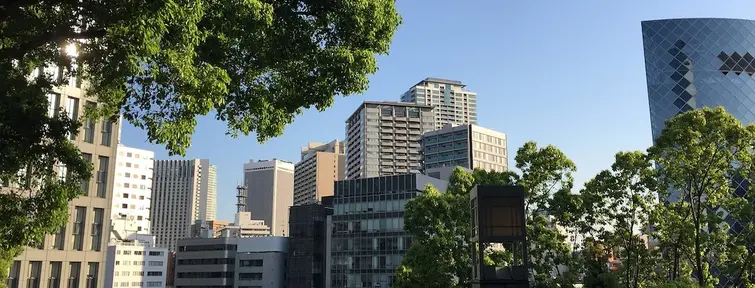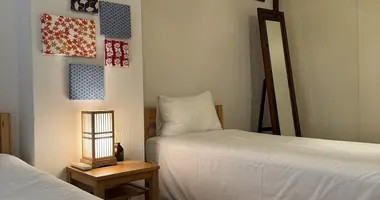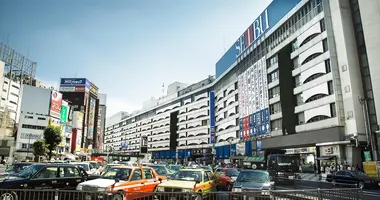Akasaka 赤坂
- Published on : 29/10/2020
- by : SR
- Youtube
Between its embassies and its excellent restaurants, Akasaka, located North of Roppongi, is one of the most exclusive areas in Tokyo.
Akasaka Area Guide
Akasaka, which sits on more than 25 hills, is one of Tokyo's high-class districts, with numerous grand hotels, famous dining and entertainment establishments, concert spaces, the headquarters of Tokyo Broadcasting System (TBS) TV, luxury accommodation, and some impressive architecture.
Akasaka is a pleasant commercial district that offers hustle and bustle at one end, and a somewhat quieter more upmarket vibe at the other. Akasaka is the closest of any shopping and entertainment district in Tokyo to Japan's center of politics, Nagatacho and also adjoins Tokyo's liveliest nightlife district, Roppongi. Akasaka strikes a balance between the two. Akasaka is narrow cobbled stretches of non-stop bars and pubs, right next to some truly spectacular office towers, and with green, eminently walkable undulating streets of expensive housing and boutique shopping.
Akasaka History
Akasaka, literally "red slope," is a corruption of akanesaka, or "madder slope," from the madder plant (Rubia tinctorum) which once grew there, its roots used to make red dye. Akasaka first appeared on the map with the establishment of the shogunate at the start of the 17th century based in Edo Castle (the present Kokyo, or Imperial Palace), just north-east of Akasaka.
The area closest to Edo Castle is Akasaka-mitsuke, meaning Akasaka Guard Post, protecting Edo Castle's south-west corner. Akasaka-mitsuke is the lowest point of the hilly Akasaka district, and is where the lowlier retainers, warriors and menials lived, while the high ground further south (i.e., in the Roppongi direction) was home to the lords.
The nearby river was fashioned into a moat around Edo Castle, with some of it channeled into a pond used as a reservoir in present day Tameikesanno - Tameike meaning "dammed pond." The ready water supply meant a cluster of eateries developed in Tameikesanno, and in the post-feudal Meiji era (i.e., from 1868) Tameikesanno became a pleasure quarter, with well over 100 geisha houses by the 1930s, frequented by nearby Nagatacho bigwigs, among others.
After the Second World War, Akasaka regained its vitality with the establishment of numerous big hotels from the mid-1950s, the relocation to Akasaka of the TBS TV broadcasting headquarters, and a vibrant nightlife scene whose big names (Mugen, New Latin Quarter, etc.) lasted through to the 1980s. Akasaka is still fun in the evening, but now on a smaller, more neighborhood scale.
Akasaka Today
In keeping with its history, the low ground of Akasaka—around Akasaka-mitsuke Station—is still more entertainment oriented, and the upper ground still more elegant. Akasaka-Mitsuke's busy, brick-paved backstreets run parallel to Sotobori-dori Avenue, which runs the length of Akasaka.
Akasaka-mitsuke is the main entertainment area in Akasaka, across from the Akasaka Excel Hotel Tokyu. There are many good pubs and restaurants and shops, and the area is full of patrons every night of the week until late.
The building that most stands out in the Akasaka townscape is the huge white Prudential Tower, also near the Akasaka Excel Hotel Tokyu, but which actually occupies the neighboring Nagatacho district.
The higher ground of Akasaka is a pleasant undulating area good for strolling and sightseeing if you want scenes of nicely landscaped, generally well designed, laid back, affluent inner city Tokyo living. South of Akasaka Station in particular there are pretty streets, local shopping complexes, cafes, restaurants, parks, gardens, embassies, and temples mostly all on a quiet, neighborhood scale.
A little north of the Akasaka district is wide, green Akasaka Goyochi ("Akasaka Estate"), a large forested tract of land expanse most notable for its Akasaka Palace that now functions as the State Guesthouse (Geihinkan) for visiting foreign dignitaries.
Toyokawa Inari Temple
Toyokawa Inari Temple in Moto-Akasaka, very near Akasaka-mitsuke, is an interesting amalgam of Japanese religious sentiment and history: a Buddhist temple dedicated to the Shinto fox god (Inari). Toyokawa Inari Temple is a branch of the main Toyokawa Inari Temple located in Toyokawa City, Aichi Prefecture (about 60km south-east of Nagoya).
Toyokawa Inari Temple is the Tokyo temple for those in the arts and entertainment sectors, and is thronged with artists and entertainers every New Year's Eve.
The venerable Toraya confectionery shop, an Akasaka tradition, is just across Aoyama-dori from Toyokawa Inari Temple, and is a great stop for some green tea and Japanese sweets after your temple visit.
Hei-jinja Shrine
South of Akasaka is Hie-jinja shrine, a true oasis of calm and spirituality, much appreciated by local employees for their lunch break. You can identify it by its gorgeous red torii tunnel covering the stairs to the shrine.
This Shinto shrine is dedicated to Oyamakui no Kami, the god of Mount Hie, renowned for providing protection from evil.
In June, the shrine comes alive with the Sanno Matsuri - one of Tokyo's biggest festivals - during which colorful processions march through the streets of Akasaka.
Akasaka Sacas
Akasaka Sacas is an urban renewal project otherwise known as the Akasaka 5-chome TBS Development Project, in front of Akasaka subway station, right in the middle of Akasaka.
Akasaka Sacas was developed in 2008 by Tokyo Broadcasting System (TBS) around it's already existing premises.
Akasaka Sacas comprises the following four buildings, plus a high rise residential building:
- TBS Broadcasting Center, built in 1994, houses TBS studios. TBS operates twice-daily weekday tours of the broadcasting center for pupils from 5th year elementary school to 3rd year high school. (Tel. 03 3746-6666, 10am-5pm)
- Akasaka Biz Tower offers a wide range of mainly dining opportunities: restaurants, cafes, bars, bakeries, and delicatessens, as well as boutiques, clinics and other stores on its B1, 1, and 2 floors. The 39 floors that tower stylishly above it are residential. Opening hours: 11am-9pm (most restaurants to 11.30 pm).
- Akasaka Blitz is a live performance space with a capacity of about 1,500 people (standing, somewhat less if seated), with a daily concert schedule featuring Japanese rock and pop.
- Akasaka ACT Theater, right behind Akasaka Blitz, is an elegant, barrier-free theater seating 1,300 people and with a schedule of singers, bands, drama, musicals, and ballet.
Tokyo Midtown
Tokyo Midtown is a shopping and cultural complex on the south-eastern corner of the Akasaka district, joining with the Roppongi district. Tokyo Midtown opened in 2007 and was developed by a consortium led by Mitsui Fudosan Co., Ltd. The green belt behind it is very attractively landscaped, and contains over 140 trees transplanted from when the site formed the grounds of the Defense Agency headquarters.
Ark Hills
Ark Hills is the first of Tokyo's urban renewal projects, opened in 1986 by the Mori company, which also built Roppongi Hills. Ark Hills straddles Akasaka and neighboring Roppongi.
Ark Hills has seven different gardens and incorporates three main buildings:
- Suntory Hall is a concert hall for classical music in Ark Hills, and boasts the collaboration of the conductor Herbert von Karajan in its acoustic and spatial design. The Ark Karajan Plaza outside the Hall is named in his honor.
- Ark Mori Building, Ark Hills' main building, is a 37-story tower that looks as if it is vertically split, making for the illusion of twin towers. Ark Mori Building contains the offices of many finance and trading companies, as well as Airbus, Societe Generale, Japan External Trade Organization (JETRO), and a large number, and range, of shops and restaurants.
- The ANA Intercontinental Tokyo Hotel is a 37-story tower next to the Ark Mori Building. The ANA Intercontinental Tokyo has numerous bars, cafes, restaurants, salons and boutiques on its 1st to 6th floors.
Akasaka Palace/Geihinkan
The Geihinkan Akasaka Palace occupies the large expanse of land known as Akasaka Goyochi, located in Moto Akasaka, at the very north of the Akasaka area, best accessed from Yotsuya Station. Geihinkan Akasaka Palace is a neo-baroque former imperial residence, completed in 1909, and has functioned as the State Guesthouse (Geihinkan) since 1974. The Geihinkan is easily visible from the Yotsuya Station area (Marunouchi Subway Line, Namboku Subway Line). The Geihinkan may be visited, but is occasionally closed to the public because of state functions there. Even when closed, it is still worth a look, even from the distance of the splendid wrought iron gates.
Togu Palace (former Omiya Palace), also on Akasaka Goyochi, is the home of Crown Prince Naruhito and his wife, Masako, but is not accessible to the public.
Akasaka Access
Akasaka can be accessed from the following subway stations, listed in approximate order of proximity to the Akasaka central business district. Note that some stations are linked to each other, i.e. directly accessible from each other without going up to ground level.
- Akasakamitsuke station (accessible from Nagatacho station) on the Marunouchi and Ginza lines
- Nagatacho station (accessible from Akasaka-mitsuke station) on the Yurakucho, Nanboku and Hanzomon lines.
- Akasaka Station on the Chiyoda line.
- Tameikesanno station (accessible from Kokkaigijidomae station) on the Marunouchi and Chiyoda lines.
- Kokkaigijidomae station (accessible from Tameikesanno station) on the Marunouchi and Chiyoda lines.
Around Akasaka
The government administrative district of Nagatacho is immediately east of Sotobori-dori, and is centered on the National Diet.
The major entertainment district of Roppongi is a few minutes walk south and south-west of Akasaka.






























